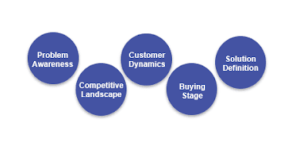Are you Gambling with your Sales Force? Take Two: Sales Agility = Better Decision Making in Conditions of Uncertainty

In our last blog, we shared that Annie Duke, one of the great professional poker players, advised that good poker is about making the best decisions under conditions of uncertainty. We explored why there is uncertainty in Texas Hold’Em; however, we are now exploring the sales environment and how those same sorts of conditions hold true. The hand above is one of the worst hands in Texas Hold’Em. However, a player can win with this hand. It all depends upon the situation and the players ability to make informed decisions.
Uncertainty with Buying Situations
In sales, as in poker, you are not in the game alone. As you pursue a sales opportunity, you encounter humans that make buying decisions. These buyers have different preferences and needs and they fulfill different roles on the buying team. They have histories and experiences that shape how they think and how they buy. The sheer number of factors that can influence a buying decision is staggering. So, how does a salesperson narrow the field? How does a seller read the buying situation in a way that leads to better decision making?
At the poker table, one of the most important factors impacting decision making is the position the player holds at any given time. In Texas Hold’Em, the best position is the last position – the dealer. The dealer has the benefit of seeing action from all the other players before making their decision. That’s golden because the player in the dealer spot has the most information at the table to aid in better decision making.
In sales, it would be great if the buying decision factors were as straight-forward. Unlike poker, there is not a single buying factor that overshadows all others. Marketers of late have made a huge fuss about buyer personas and buying journeys. In fact, they’ve placed their bet that these are two most important factors to consider when pursuing a sales opportunity. Our research doesn’t support this notion. After researching over 1,600 sellers, and over 3,200 deals over the last four years, we’ve determined that there are five categories of factors that consistently impact buying decisions. Not two, but five.
Buying Situation Factors That Matter
Although we’ve evaluated over 25 factors impacting buying decisions, after careful analysis, we’ve been able to tease out five categories of factors that consistently impact buying decisions.

As you will surmise, buyer personas and the buying journey only impact two of the five categories. And each category has more than one factor. The practical conclusion is that our marketing folks have provided answers to only part of the story. As sellers, we need the broader picture. We need a picture that more accurately reflects how our buyers buy. Not only have we identified five categories of buying factors, we now know that within each category, there is one buying factor that has an outsized influence on the buying situation.
How Buying Factors Result in Unique Buying Situations
Ok, let’s catch our breath here. So, there are five categories of buying factors and within each category, one factor has an outsized influence on the buying situation. Now what? Well, now the really interesting insights begin to emerge. We can (and do) analyze how these five buying factors cluster together to form unique buying situations sellers face. In our four years of research, we’ve found that each company’s sellers face an average of four to six unique buying situations. Even companies in the same industry have slightly different buying factors that influence their unique buying situations. This is most certainly not a one size fits all affair.
By using machine learning, we can reduce a highly complex buying environment into one that sellers can identify, understand, and act upon. We’ve been able to dramatically simplify seller decision making in conditions of uncertainty. We’ve reduced the complexity of over 25 possible buying factors into five. At the same time, we’ve provided a more comprehensive picture of buying situations that include, but are not limited to, buyer personas and the buying journey. Imagine the delight a team of sales and marketing leaders feels when they can incorporate this level of precision in their sales training? Imagine the impact this type of insight has on the effectiveness of sales coaching? It is mind blowing.
Read our next blog to learn how high performing sellers adapt to different buying situations.
If interested in further discussions around this topic, contact me at mvazzana@vantagepointperformance.com. In addition, you can watch our video “How Machine Learning is Changing the Game of B2B Sales”
VantagePoint Performance is now part of Imparta, a global leader in performance improvement for customer-facing teams.
